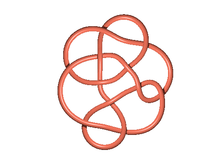Lisa Piccirillo
Lisa Piccirillo is an American mathematician who works on geometry and low-dimensional topology. In 2020, Piccirillo published a mathematical proof in the journal Annals of Mathematics determining that the Conway knot is not a slice knot,[1] answering an unsolved problem in knot theory first proposed over fifty years prior by English mathematician John Horton Conway.[2]
Lisa Piccirillo | |
|---|---|
| Nationality | American |
| Alma mater | Boston College, University of Texas at Austin |
| Known for | Solving the Conway knot |
| Scientific career | |
| Fields | topology, knot theory |
| Doctoral advisor | John Luecke |
Education
Piccirillo earned a B.S. in Mathematics from Boston College in 2013 and a PhD in low-dimensional topology at the University of Texas at Austin under the supervision of John Luecke in 2019, followed by postdoctoral research at Brandeis University.[2][3][4] Boston College professor Elisenda Grigsby cited Piccirillo's creativity as contributing to her success, adding that Piccirillo did not fit the mold of a "standard golden child math prodigy" during her undergraduate studies.[2]
Work

The Conway knot was a famous, long-standing unsolved problem in knot theory.[2][5] The knot was named after its discoverer, English mathematician John Horton Conway, who first wrote about the knot in 1970. The Conway knot was determined to be topologically slice in the 1980s; however the nature of its sliceness, and whether or not it was smoothly slice, eluded mathematicians for decades up until Piccirillo's breakthrough.[2] Piccirillo's work on the Conway knot completed the classification of slice knots with under thirteen crossings, as the Conway knot had been the last outstanding knot in its group fully unclassified.[1]
The Conway knot problem was notable not only for its age—remaining unsolved for over half a century—but also because the nature of the question itself regarding the sliceness of the Conway knot was "connected to some of the deepest questions in four-dimensional topology." According to Boston College mathematician Joshua Greene, the question of "whether the Conway knot is slice, had been kind of a touchstone for a lot of the modern developments around the general area of knot theory."[2]
Piccirillo first learned of the Conway knot problem in 2018 at a conference on low-dimensional topology and geometry.[2][6] She was a graduate student at the time and spent less than a week working on the knot in her free time before finding an answer.[5] The Washington Post reported that her proof had been "hailed as a thing of mathematical beauty, and her work could point to new ways to understand knots."[5] Following the publication of Piccirillo's proof in Annals of Mathematics, she was offered a tenure-track position at the Massachusetts Institute of Technology set to begin fourteen months after the completion of her doctorate.[2][7]
References
- Piccirillo, Lisa (2020). "The Conway knot is not slice". Annals of Mathematics. 191 (2): 581–591. arXiv:1808.02923. doi:10.4007/annals.2020.191.2.5. ISSN 0003-486X. JSTOR 10.4007/annals.2020.191.2.5.
- Klarreich, Erica. "Graduate Student Solves Decades-Old Conway Knot Problem". Quanta Magazine. Retrieved May 20, 2020.
- "Curriculum vitae". Retrieved May 19, 2020.
- "Studying Knots and Four-Dimensional Spaces". University of Texas at Austin. Retrieved May 20, 2020.
- Blakemore, Erin. "Graduate student untangles nature of Conway knot". The Washington Post. Retrieved May 26, 2020.
- Delbert, Caroline (May 22, 2020). "Young Mathematician Solves Old, Famous Knot Problem in Barely a Week". Popular Mechanics. Retrieved May 26, 2020.
- "Lisa Piccirillo Solves Decades-Old Conway Knot Problem – Women In Math". math.mit.edu. Retrieved May 26, 2020.